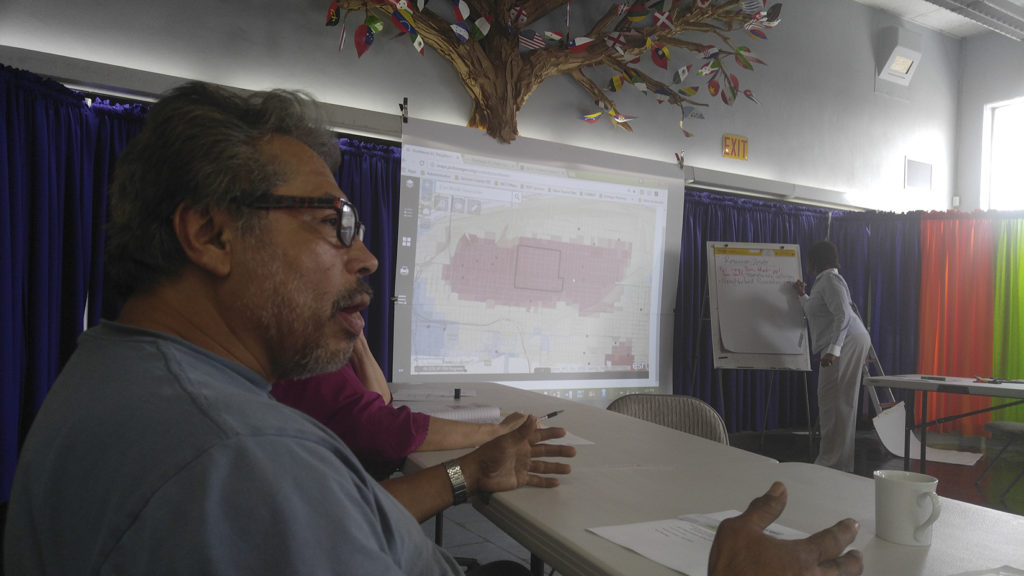
By Michael Bushnell
Northeast News
April 14, 2017
KANSAS CITY, Missouri – Violent crime was the primary topic of conversation on the afternoon of Thursday, April 13 at
the Northeast Chamber of Commerce office, where Jackson County COMBAT hosted a meeting of Northeast community stakeholders.
The meeting was part of a coordinated attempt to bring additional resources to an area along Independence Avenue riddled with blight, prostitution and chronic violent crime. Billed as the NE Kansas City Violence Reduction Initiative, the group’s first meeting was in late February. At that meeting, COMBAT Deputy Director Vince Ortega stated that the city’s number-one crime hot spot was Northeast Kansas City, citing an area bounded by Manchester Trafficway on the East, Charlotte Street on the West, Cliff Drive on the North and 12th Street on the
South. Stakeholders in attendance at that meeting were tasked with scaling down the area to a more workable target zone that would encompass two Northeast neighborhoods bordering the central region of the Independence Avenue corridor.
The April 13 meeting was attended by representatives of COMBAT, KCPS, the Police Department’s East Patrol Division, the Northeast Chamber and Avenue CID, NEAT and two area neighborhood associations with an active interest in the reduction of violent crime: Indian Mound and Independence Plaza. When asked about the “new” hot spot boundaries, both Tom
Ribera of Independence Plaza and Manny Abarca of Indian Mound expressed concern that the area was designed without neighborhood association input. Additionally, both indicated that the target area needed to be expanded.
“We’ve got some real issues in the South Indian Mound neighborhood, specifically the area South of Budd Park, that need to be included in this hot spot area,” said Abarca. “The type of crime you’re targeting transcends neighborhood boundaries and negatively impacts quality of life for both residents as well as small businesses along the Avenue corridor.”
Abarca’s comment proved prophetic – less than 12 hours later, a double shooting resulted in a homicide on the 400 block of S. Colorado.
Tom Ribera agreed with Abarca’s statement, stating that vagrancy, prostitution, drug dealers and vacant houses all play an active role in the cycle of violent crime in Northeast.
“There are a number of extremely hot crime areas outside of this very small area you’ve given us,” said Ribera, pointing out the area of Independence and Cypress and Independence and Bellefontaine, where prostitution and rampant drug-dealing go virtually unchecked on a
daily basis. “Business in this area suffer because of the vagrancy, the crime and the panhandling that exist along the Avenue.”
Northeast Chamber of Commerce President and Independence Avenue CID Director Bobbi Baker Hughes indicated that the CID is looking at some creative ways to address the vagrancy and panhandling issues, and stated that part of the plan for the next fiscal year was the possibility of expanding the CID south along the Prospect corridor to address the same
issues with violent crime.
Ribera also noted the lack of an operating community center where area youth could congregate for a variety of activities.
“There’s nowhere for these kids to go, so a lot of times they take to the streets and end up being a part of the justice system instead of being productive members of of the community,” he said.
When the now vacant Scarritt School was brought up as a possible location for a community center, KCPS Representative Rick Bishop indicated that the school had previously been slated by the district for potential re-use as an elementary and early childhood learning center. The school, however, has been vandalized inside and out to the point where its fate is now in jeopardy. During a follow-up conversation with Ortega on April 14, he hinted that the old school could very well be adaptively re-purposed as a community center through COMBAT’s partnership in this initiative, and due to its central location within the defined target area.
“That really could be developed into a great asset for the community” he said.
When asked about the lack of neighborhood associations present at the meetings, Ortega indicated that it was not exclusionary in any way.
“We wanted to make sure we had good data and good intel in-house before we brought the neighborhoods to the table,” said Ortega. “We’ve asked key people to reach out to those neighborhoods and to make sure they have someone present at the upcoming meetings so we can place our resources where they’ll do the most good.”
The next NE KC Violence Reduction Initiative will be held in May.

















